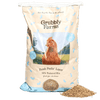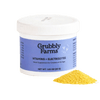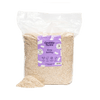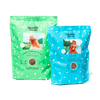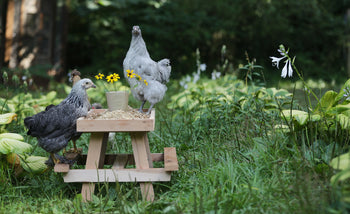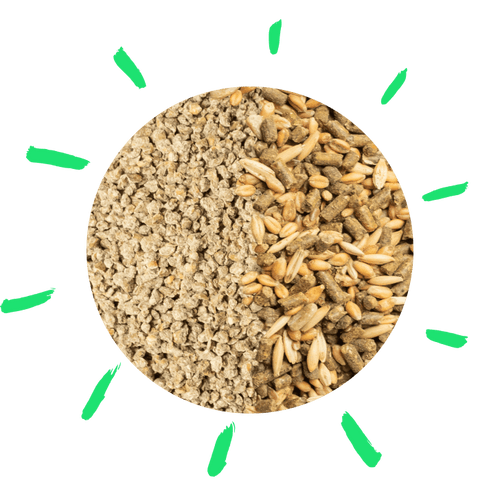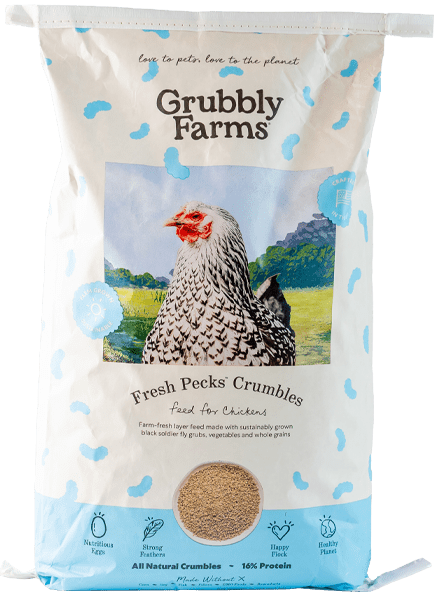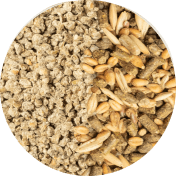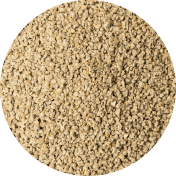As a pet owner, you always want what’s best for your fluffy ones. Whether you have a cat, dog, or flock of chickens, choosing the best diet is part of providing them with the best health and happiness. If you’re like most pet owners, you likely compare pet foods based on their ingredients and guaranteed analysis. If so, you’ve likely noticed a lot of foods with fish and fishmeal listed. But you won’t find these ingredients in Grubbly Farms’ products. Why? Because our products reflect our mission: to provide the best health for your pet and the planet.
Fish-Free is the Grubbly Way to Be
While many pet food companies use fish and fishmeal to boost the Omega-fatty acids and protein in their foods, we take a different approach. With insect protein, we’re able to provide pets with nutritious snacks and feed without compromising the health of our planet. Plus, many pet parents are surprised to learn that fish and fishmeal aren’t always the healthiest choice for their fluffy ones.
What Is Fishmeal and What Is It Used For?
Fishmeal is a concentrated, highly-processed fish powder often added to pet and chicken feeds to supplement the feed’s level of protein. It is created through a cooking and pressing process that removes nearly all the moisture and oil. Fishmeal is made as a byproduct of fish caught for human consumption. This means that it includes parts people don’t want to or can’t eat, such as bones.
However, there are some fish caught specifically to transform into fishmeal. These fish do not have a high level of commercial value for human consumption and include herring, pollock, and menhaden. These species are often referred to as “bony trash fish” and “forage fish.”
Fish-Free Feed Puts Your Fluffy Ones’ Health First

While fish comes with a wide array of benefits–there are also some risks that arise from feeding your pets fish and fishmeal. Often these risks come down to the type of fish, where the fish was sourced and processed, as well as, your pet’s individual dietary needs. However, if you have yet to explore how fish can affect your pets, we encourage you to dive deeper. To get you started, we’ve selected the most common issues reported by vets, scientists, and pet owners.
Fish can cause kidney issues and obesity in chickens
Fish is often viewed as a universally healthy food for flocks, people, and other pets. However, for some flocks, fish presents a unique issue: too much protein. Fish contains between 60% and 71% protein, which is considered a high-protein diet for chickens on its own (most vets recommend about 20% protein daily for adult chickens). If not properly balanced with other ingredients, these high concentrations of protein can be difficult for the kidneys to process. This can lead to kidney issues and obesity in the long term.
Fishmeal can contain high levels of mercury & other heavy metals
Fish farms have come under scrutiny over the past few years. While these aquatic farms have widespread ecological implications (see below), they have also become a source of pet feed contamination. The contaminants found in feed with fish include cadmium, lead, arsenic, and mercury [1]. Prolonged exposure to mercury in feed leads to an accumulation of mercury in a chicken’s muscles, feathers, claws, kidneys, and eggs [2].
Fishmeal can harbor foodborne pathogens
One of the biggest health concerns related to fish in chicken feed is the risk of foodborne pathogens, including Salmonella. This bacteria can poison an entire flock and make your chickens very sick. Unfortunately for many chickens, Salmonella thrives in the fishmeal factory setting [3]. In some studies, the presence of this bacteria took years for factories to remedy. More shockingly, the persistence of Salmonella in fish-based animal feeds does not appear to be becoming less prevalent [4].
Even more frightening, this bacteria can spread to flock owners and their families. Outbreaks of Salmonella in humans can often be linked to contaminated feed [5].
Fish in feed can lead to fish-flavored eggs
If you’ve heard the saying, “you are what you eat,” then you’re familiar with the idea that diet has a profound effect on your health. Diet also plays a significant role in the flavor and color of your hens’ eggs. That “fishy” flavor is a side effect of the Omega-3 fatty acids present in fish and fishmeal [6]. And while chickens need Omega-3s, choosing an alternative source such as flax seed can reduce that unpleasant fishy flavor and scent in your eggs.
Fish & Fishmeal is Harmful to the Planet
Since the 1960s, fish has become a larger part of the human diet--in fact, the average person eats twice as much fish as they would have just 50 years ago. While much of the fish used in commercial pet feed is a byproduct of seafood caught for people, more and more pet foods are opting for human-grade fish and fish caught solely for the purpose of feeding pets. This adds to the strain fishing has on the environment.
Commercial fishing and farm-raised fish are the two primary sources of fish for feeds. We will cover how each of these approaches affects our planet and shine some light on why we opt for a more sustainable protein like grubs for Grubbly Farms’ feeds and snacks.
A Closer Look at Commercial Fishing

Commercial fishing includes collecting and catching fish from the wild. This can be through hook-and-line methods (which are the most sustainable) or netting. While the U.S. has regulations in place to prevent overfishing and protect our environment, many other countries where fish for pet feed are caught do not have the same. Additionally, the ocean is an interconnected ecosystem–and the less-than-ideal practices in other parts of the world affect the entire ocean as well as seabird species that rely on the ocean for food.
Depletion of the Seas
The most apparent effect commercial fishing has on the environment is a reduction in the number of fish in the sea. According to the Marine Stewardship Council, 34% of global fish stocks are currently overfished [7]. This means that more fish are being removed from the ocean than new fish are being created through reproduction. And when fishing outpaces reproduction, populations decline.
In 2011, experts estimated the fishing industry removes about 1 trillion to 2.7 trillion wild fish from oceans across the world annually [8]. That number has shifted to between .8 trillion and 2.3 trillion wild fish removed from the seas in 2019. And while this change may appear positive, it’s important to note that the drop in total fish caught is due to the decline in the Peruvian anchovy population along with several other fish species.
Reduction of Biodiversity
A quick glance at pet food flavors shows that most people tend to favor particular species of fish. This can be linked to pet owners wanting to A) recognize what their pets eat, and B) provide their pets with a diet that reflects their own. Additionally, there are many recognized benefits found in certain species, such as salmon and tuna, making these species high-sought after. Unfortunately, this has led to fishing operations targeting these species at an alarming rate and an imbalance in the oceanic ecosystem [9].
Smaller species, such as krill, have also faced greater targeting as many pet foods and pet treat producers want to boost their products’ nutritional levels with fish oil.
Habitat Damage & Pollution
Overfishing and climate change have created widespread problems for marine habitats, including coral reefs. The Nature Conservancy estimates that the fishing industry is responsible for over 100 million pounds of plastics entering the ocean every year [10]. These plastics lodge themselves in oceanic habitats or float along, becoming a hazard for seabirds, sea turtles, and other marine species [11]. Along with large plastic refuse, microplastics have also become ubiquitous in our seas.
According to the Ocean Conservancy, “Around 74% of fillets and 63% of livers had at least one microplastic present, while 99% of fish had at least one particle present in any of the three studied tissues” [12].
Not only does the physical presence of nets, anchors, pots/traps, and lost fishing gear wreak havoc on natural habitats, but a reduction in fish has resulted in an increase in coral bleaching and fish nurseries [12]. Without these habitats, future generations of fish and marine life are left without a place to lay their eggs, raise their young, and find refuge from large predators.
Along with plastic pollutants, many vessels release oil into the water through their bilges. These oil leaks present a long-term and costly effect on marine ecosystems.
Oil Consumption for Fishing Vessels
Fishing vessels add to the growing problem of climate change through the use of oil. The depletion of fish stocks has worsened this problem over time since boats must expend more time and fuel covering more area in order to catch the same amount of fish.
The Problem of By-Catch
By-catch (fish caught or injured unintentionally while targeting other species) is inevitable and presents another laundry list of environmental issues. One of the greatest problems is that by-catch is often discarded back into the ocean and goes unreported, leaving scientists in the dark about the health of by-catch populations.
Additionally, what species wind up caught by mistake can run the gambit, including turtles, dolphins, and even seabirds. In fact, the U.S. implemented by-catch safe practices after scientists estimated that over 300,000 dolphins and whales and 250,000 sea turtles were killed or injured annually due to commercial fishing [13].
Fish Farming

As a way to increase fish production, many companies have turned to farmed fish–and for decades, this was seen as a more sustainable practice. While these fish farms present a unique approach to raising fish, they also create an array of other ecological pitfalls.
The most common approach to fish farming (or “aquaculture”) is to raise fish in densely populated, floating pins–the conditions of these pens are often compared to the battery-style cages used in the egg industry.
Farmed Fish Often Survive on Soy
Most fish raised in aquatic farms rely on soybeans as their primary source of protein. In fact, these small green beans are often credited with the success of aquaculture farms. Soybeans may be high in protein compared to other crops, but they only have a fraction of the nutrients fish would gain from a natural of smaller fish and crustaceans.
Additionally, fish would never eat soybeans without human intervention, leading to unnatural results. A side effect of eating so much soy is that the fish produce a lot more waste, which harms surrounding fish populations and habitats.
The soy farming needed to keep up with the demand from fish farms has led to deforestation to create farmland. Additionally, the nitrogen used in fertilizers for soy often winds up as farm run-off and washing out to sea.
Fish Farms Cause Habitat Destruction
Most fish farms are located along coastal regions where marine habitat is already at-risk due to boats’ wake, seawalls, pollution, and rising sea levels. These areas are where juvenile fish grow up in the safety and shelter of shallow waters, seagrass, and mangrove roots. Some fish farms even transform natural shorelines into ponds to house pens, completely eliminating the coastal nurseries.
Fish Pens Lead to Unique ‘New’ Ocean Pollutants
Fish farming causes pollution through concentrated levels of fish poop, the use of parasite control chemicals, and other sediments. The need to grow farmed fish to marketable size requires a lot of feed–which results in a lot of waste. This fish waste and excess feed washes into the surrounding water and beyond, resulting in an imbalance in nutrient levels [14]. This imbalance has been linked to a change in pelagic fish’s natural habits and a possible increase in harmful algal blooms.
Pinned Fish Spread Disease
The high density of fish within pens leads to the spread of parasites and diseases among fish. To treat and prevent disease, many fish farms treat pens with antibiotics and parasiticides. However, the free-flowing water transports disease beyond the boundaries of the fish pens, infecting wild fish that in turn take the disease even further beyond the farm. Wild Pacific salmon, an endangered species, is one of the latest species threatened by a virus that has been traced back to fish farms [15].
How You Can Help Protect the Planet and Your Pets
When it comes to finding the best diet for your pet, it can be difficult to take in all the information needed to make an informed decision. As a pet parent, you can make a major impact by opting for products that provide the best nutrition and use sustainable practices. Taking the time to understand how the products you provide your pets are made, where they come from, and what exactly goes into them is a great first step!
Learn more about how Grubbly’s dog snacks are better for pups and the environment.
Grubbly Farms: Giving Love to Our Oceans One Grub at a Time

When it comes to pet health and a commitment to doing good, there’s nothing fishy about Grubbly Farms. Our grub-based products are 100% fish-free and offer pet parents a choice that provides their fluffy ones with wholesome nutrition without compromising the environment. In fact, Grubbly products offset waste while protecting the oceans. We’re happy to play a part in protecting the places that fuel the fun and beauty of life. Learn more about how grubs are a superfood with super benefits!
Here’s to brighter days!
References:
[1] https://www.tandfonline.com/doi/full/10.1080/19440049.2017.1300686
[2] https://www.sciencedirect.com/science/article/pii/S0032579119493565
[3] https://link.springer.com/article/10.1186/1746-6148-5-20
[4] https://www.frontiersin.org/articles/10.3389/fvets.2021.727495/full
[5] https://academic.oup.com/cid/article/35/7/859/307143
[6] https://www.feedstrategy.com/blog/how-to-reduce-fishy-flavor-in-omega-3-enriched-eggs/
[7] https://www.msc.org/en-us/media-center/msc-at-a-glance/products-sold
[8] http://fishcount.org.uk/fish-count-estimates-2/numbers-of-fish-caught-from-the-wild-each-year
[9] https://www.worldwildlife.org/species/tuna
[10] https://www.nature.org/en-us/newsroom/ca-ocean-plastic
[11] https://www.pewtrusts.org/en/research-and-analysis/articles/2018/09/24/plastic-pollution-affects-sea-life-throughout-the-ocean
[12] https://pubmed.ncbi.nlm.nih.gov/20405798/
[13] http://ucsdclimatereview.org/post/the-environmental-impact-of-the-fishing-industry
[14] https://www.researchgate.net/publication/283853885_Perspectives_of_nutrient_emission_from_fish_aquaculture_in_coastal_waters_Literature_review_with_evaluated_state_of_knowledge

